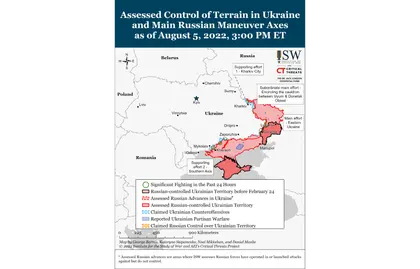Key Takeaways
- Ukrainian officials confirmed that Russian forces are using Iranian-provided drones in Ukraine.
- Russian forces conducted unsuccessful ground assaults on settlements south of Bakhmut.
- Russian and Ukrainian forces exchanged heavy artillery fire in Pisky, suggesting that Russian forces are unlikely to have full control of Pisky despite Russian claims.
- Russian forces conducted several limited ground assaults to the north, northwest, and southwest of Donetsk City.
- Russian and Ukrainian forces accused each other of firing rounds near the Zaporizhia Nuclear Power Plant (NPP) in Enerhodar, but ISW cannot independently determine which party is responsible for the incident.
- Russian forces have repeatedly used artillery systems deliberately positioned within the complex to fire on targets across the Dnipro River.
- Russian forces unsuccessfully attempted to advance on Lozove, Kherson Oblast, likely targeting the Ukrainian bridgehead over the Inhulets River.
- Russian federal subjects are forming new volunteer battalions in Omsk and Samara Oblasts.
- Russian occupation authorities are likely accelerating passportization and rubleization efforts and civilian data collection in occupied territories in preparation for the upcoming pseudo-referenda on the annexation of occupied Ukrainian territory into Russia.
- The Kremlin is continuing to replace Ukrainian collaborators in Russian occupation administrations with Russian officials, likely to prepare for formal Russian governance of annexed areas.
Ukrainian officials confirmed that Russia is using Iranian-provided drones in Ukraine. Advisor to the Ukrainian President’s Office, Oleksiy Arestovych, stated on August 5 that Iran handed 46 drones over to Russia and that the Ukrainian government has already noted the use of these drones in combat in Ukraine. [1] At least a portion of the provided drones are older-generation “Shahed 129” heavy strike drones, which Russian forces may seek to use to attack US-provided HIMARS in Ukraine. [2] It is unclear whether the 46 drones represent all the drones that Tehran has agreed to send, or the number of Iranian drones that are currently operating in Ukraine.
JOIN US ON TELEGRAM
Follow our coverage of the war on the @Kyivpost_official.
Authors: Kateryna Stepanenko, Layne Phillipson, Karolina Hird, Katherine Lawlor, Angela Howard, and Frederick W. Kagan
See the full report here.
You can also highlight the text and press Ctrl + Enter







